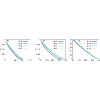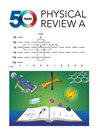通过噪声密集编码协议实现安全信息交易的维度优势
IF 2.9
2区 物理与天体物理
Q2 Physics and Astronomy
引用次数: 0
摘要
量子密集编码(DC)协议没有安全特性,它是通过在单个发送方和单个接收方之间使用共享纠缠来传输以量子态编码的经典信息。它的适当变体已被确立为共享双量子比特最大纠缠态的量子密钥分发(QKD)方案,其安全性证明利用了互补观测体的不确定性关系和肖-普雷斯基尔纠缠净化方案。我们提出了适用于高维系统的基于 DC 的 QKD 协议,并报告了当共享态为双量子最大纠缠态和不同等级的最大纠缠态混合物时的密钥率下限。分析还包括编码前后噪声信道对安全密钥率的影响。在无噪声和有噪声两种情况下,我们都证明了密钥速率以及协议对噪声的鲁棒性随着维度的增加而增加。此外,我们还证明了基于 DC 的 QKD 协议中的无用状态集是凸紧凑的。本文章由计算机程序翻译,如有差异,请以英文原文为准。

Dimensional advantage in secure information trading via the noisy dense-coding protocol
The quantum dense-coding (DC) protocol, which has no security feature, deals with the transmission of classical information encoded in a quantum state by using shared entanglement between a single sender and a single receiver. Its appropriate variant has been established as a quantum key distribution (QKD) scheme for shared two-qubit maximally entangled states, with the security proof utilizing the uncertainty relation of complementary observables and the Shor-Preskill entanglement purification scheme. We present the DC-based QKD protocol for higher-dimensional systems and report the lower bounds on the secret key rate, when the shared state is a two-qudit maximally entangled state, and mixtures of maximally entangled states with different ranks. The analysis also includes the impact of noisy channels on the secure key rates, before and after encoding. In both the noiseless and the noisy scenarios, we demonstrate that the key rate as well as the robustness of the protocol against noise increases with the dimension. Further, we prove that the set of useless states in the DC-based QKD protocol is convex and compact.
求助全文
通过发布文献求助,成功后即可免费获取论文全文。
去求助
来源期刊

Physical Review A
物理-光学
CiteScore
5.40
自引率
24.10%
发文量
0
审稿时长
2.2 months
期刊介绍:
Physical Review A (PRA) publishes important developments in the rapidly evolving areas of atomic, molecular, and optical (AMO) physics, quantum information, and related fundamental concepts.
PRA covers atomic, molecular, and optical physics, foundations of quantum mechanics, and quantum information, including:
-Fundamental concepts
-Quantum information
-Atomic and molecular structure and dynamics; high-precision measurement
-Atomic and molecular collisions and interactions
-Atomic and molecular processes in external fields, including interactions with strong fields and short pulses
-Matter waves and collective properties of cold atoms and molecules
-Quantum optics, physics of lasers, nonlinear optics, and classical optics
 求助内容:
求助内容: 应助结果提醒方式:
应助结果提醒方式:


